You can help expand this article with text translated from the corresponding article in Polish. (January 2025) Click for important translation instructions.
|
Place in Lesser Poland Voivodeship, Poland
| Oświęcim | |
|---|---|
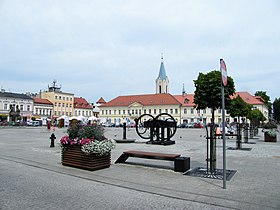 Old Market Square Old Market Square | |
 Flag Flag Coat of arms Coat of arms | |
 | |
| Coordinates: 50°02′17″N 19°13′17″E / 50.03806°N 19.22139°E / 50.03806; 19.22139 | |
| Country | |
| Voivodeship | Lesser Poland |
| County | Oświęcim |
| Gmina | Oświęcim (urban gmina) |
| Established | First mentioned in 1117 |
| City rights | 1291 |
| Government | |
| • City mayor | Janusz Chwierut (PO) |
| Area | |
| • Total | 30.3 km (11.7 sq mi) |
| Elevation | 230 m (750 ft) |
| Population | |
| • Total | 34,170 |
| Time zone | UTC+1 (CET) |
| • Summer (DST) | UTC+2 (CEST) |
| Postal code | 32–600, 32–601, 32–602, 32–603, 32–606, 32–610 |
| Area code | +48 033 |
| Car plates | KOS |
| Website | Oświęcim |
Oświęcim (Polish: [ɔˈɕfjɛɲtɕim] ; German: Auschwitz [ˈaʊʃvɪts] ; Yiddish: אָשפּיצין, romanized: Oshpitzin; Silesian: Uośwjyńćim) is a town in the Lesser Poland (Polish: Małopolska) province of southern Poland, situated 33 kilometres (21 mi) southeast of Katowice, near the confluence of the Vistula (Wisła) and Soła rivers. The town is known internationally for being the site of the German Nazi-built Auschwitz concentration camp (the camp is also known as KL or KZ Auschwitz Birkenau) during World War II, when Poland was occupied by Nazi Germany.
Name

The name of the town is of Polish/Slavic extraction, possibly derived from the owner of a Slavic gord which existed there in the Middle Ages. Some Medieval spellings of the name are: Oswenin (1217), Osvencin (1280), Hospencin (1283), Osswetem (1290), Uspencin (1297), Oswentim (1302) etc. It has been spelled many different ways and known by many different languages over time, including Czech, German, and Latinised versions.
The town was an important center of commerce from the late Middle Ages onward. Fourteenth-century German-speaking merchants called it Auswintz; by the 15th century, this name had become Auschwitz. From 1772 to 1918 Oświęcim belonged to the Habsburg Kingdom of Galicia and Lodomeria (from 1804 a crownland of the Austrian Empire and 1867 Austria-Hungary), and both Polish and German names were in official use. The town was annexed into Nazi Germany during World War II and the name Auschwitz was used. It became known as Oświęcim after 27 January 1945, when the Wehrmacht was pushed out by the Red Army.
Geography and transport
Oświęcim lies at the intersection of National Road 44 and local roads 933 and 948. Oświęcim's old town is east of the Soła, with the Main Market Square (Rynek Główny) at its center. The railway station is across the river in the northwest part of town; the main museum is on the west side. The Auschwitz-Birkenau State Museum is in the village of Brzezinka, to the west of the railway station. The chemical works are east of the town.
The main bus station of the town lies in the east of the town, and local bus services are operated by PKS Oświęcim. The PKP railway services are available to Kraków, Katowice and Czechowice-Dziedzice, and internationally to Vienna and Prague. The nearest airport is 60 kilometres (37 miles) away, at Kraków Balice. According to the 2002 data, Oświęcim is 30 km, of which forests comprise only 1%. The neighbouring boroughs (gmina) are Chelmek, Libiąż, and the gmina of Oświęcim.
Climate
Oświęcim has a warm-summer humid continental climate characterised by four distinct seasons: spring, summer, autumn, and winter. Located in the Oświęcim Basin, the town experiences relatively high precipitation that averages slightly below 1000 mm per year. The precipitation is fairly evenly distributed throughout the year, though the spring and summer seasons tend to receive more. Summers are warm and humid, but frequently cloudy due to the influence of polar maritime air masses; winters are cold and windy, with snow cover. Fog is very common throughout the year. Due to its frequency, fog is considered one of the town's trademarks.
| Climate data for Oświęcim (1991–2021) | |||||||||||||
|---|---|---|---|---|---|---|---|---|---|---|---|---|---|
| Month | Jan | Feb | Mar | Apr | May | Jun | Jul | Aug | Sep | Oct | Nov | Dec | Year |
| Mean daily maximum °C (°F) | 0 (32) |
2 (36) |
7 (45) |
14 (57) |
18 (64) |
21 (70) |
23 (73) |
23 (73) |
18 (64) |
13 (55) |
8 (46) |
2 (36) |
12 (54) |
| Daily mean °C (°F) | −4 (25) |
−2 (28) |
3 (37) |
9 (48) |
13 (55) |
17 (63) |
19 (66) |
18 (64) |
14 (57) |
9 (48) |
4 (39) |
−1 (30) |
8 (46) |
| Mean daily minimum °C (°F) | −7 (19) |
−5 (23) |
−2 (28) |
3 (37) |
8 (46) |
12 (54) |
14 (57) |
14 (57) |
9 (48) |
4 (39) |
1 (34) |
−3 (27) |
4 (39) |
| Average precipitation mm (inches) | 60 (2.4) |
56 (2.2) |
65 (2.6) |
66 (2.6) |
102 (4.0) |
101 (4.0) |
114 (4.5) |
87 (3.4) |
86 (3.4) |
64 (2.5) |
63 (2.5) |
58 (2.3) |
922 (36.3) |
| Average precipitation days (≥ 0.1 mm) | 10 | 9 | 10 | 9 | 11 | 10 | 11 | 9 | 9 | 9 | 9 | 10 | 116 |
| Average snowy days (≥ 0 cm) | 26 | 25 | 20 | 6 | 0 | 0 | 0 | 0 | 0. | 3 | 11 | 24 | 115 |
| Average relative humidity (%) | 83 | 82 | 75 | 69 | 72 | 73 | 73 | 72 | 75 | 79 | 84 | 82 | 76 |
| Source 1: Meteomodel.pl | |||||||||||||
| Source 2: Climate-data.org | |||||||||||||
History
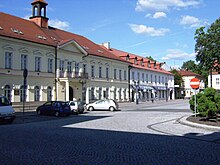
Oświęcim has a rich history, which dates back to the early days of Polish statehood. It is one of the oldest castellan gords in Poland. Following the Fragmentation of Poland in 1138, Duke Casimir II the Just attached the town to the Duchy of Opole in c. 1179 for his younger brother Mieszko I Tanglefoot, Duke of Opole and Racibórz. The town was destroyed in 1241 during the Mongol invasion of Poland. Around 1272 the newly rebuilt Oświęcim was granted a municipal charter modeled on those of Lwówek Śląski (a Polish variation of the Magdeburg Law). The charter was confirmed on 3 September 1291. In 1281, the Land of Oświęcim became part of the newly established Duchy of Cieszyn, and in c. 1315, an independent Duchy of Oświęcim was established. In 1327, John I, Duke of Oświęcim joined his Duchy with the Duchy of Zator and, soon afterwards, his state became a vassal of the Kingdom of Bohemia, where it remained for over a century. In 1445, the Duchy was divided into three separate entities – the Duchies of Oświęcim, Zator and Toszek. In 1457 Polish King Casimir IV Jagiellon bought the rights to Oświęcim. On 25 February 1564, King Sigismund II Augustus issued a bill integrating the former Duchies of Oświęcim and Zator into the Kingdom of Poland. Both lands were attached to the Kraków Voivodeship, forming the Silesian County. Before 1564, Oświęcim was semi-independent in Poland and enjoyed an extensive degree of autonomy, similarly to Royal Prussia. The town later became one of the centers of Jewish culture in Poland.

Like other towns of Lesser Poland, Oświęcim prospered in the period known as Polish Golden Age. This period came to an abrupt end in 1655, during the catastrophic Swedish invasion of Poland. Oświęcim was burned and afterward, the town declined, and in 1772 (see Partitions of Poland), it was annexed by the Habsburg Empire, as part of the Kingdom of Galicia and Lodomeria, where it remained until late 1918. After the 1815 Congress of Vienna, the town was close to the borders of both Russian-controlled Congress Poland, and the Kingdom of Prussia. In the 1866 war between Austria and the Prussian-led North German Confederation, a cavalry skirmish was fought at the town, in which an Austrian force defeated a Prussian incursion.
In the second half of the 19th century, Oświęcim became an important rail junction. During the same period, the town burned in several fires, such as the fire of 23 August 1863, when two-thirds of Oświęcim burned, including the town hall and two synagogues; a new town hall was built between 1872 and 1875. In another fire in 1881, the parish church, a school, and a hospital burned down. In 1910, Oświęcim became the seat of a starosta, and in 1917–18 a new district, Nowe Miasto, was founded. In 1915, a high school was opened. After World War I, the town became part of the Second Polish Republic's Kraków Voivodeship (Województwo Krakowskie). Until 1932, Oświęcim was the seat of a county, but on 1 April 1932, the County of Oświęcim was divided between the County of Wadowice, and the County of Biała Krakowska.
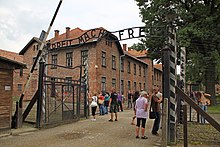
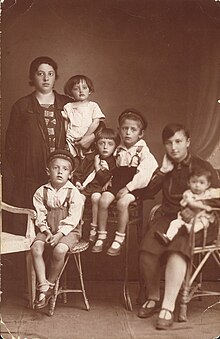
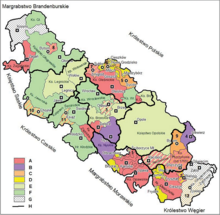
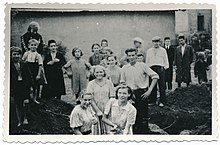
World War II
For the nearby concentration and extermination camps, see Auschwitz concentration camp.There were approximately 8,000 Jews in the town on the eve of World War II, comprising less than half the population. The Nazis annexed the area to Germany in October 1939 in the Gau of Upper Silesia, which became part of the "second Ruhr" by 1944.
In 1940, Nazi Germany used forced labor to build a new subdivision to house Auschwitz guards and staff, and built a large chemical plant of IG Farben in 1941 on the eastern outskirts of the town. Polish residents of several districts were forced to abandon their houses, as the Germans wanted to keep the area empty around Auschwitz concentration camp. They planned a 40 square kilometres (15 sq mi) buffer zone around the camp, and they expelled Polish residents in two stages in 1940 and 1941. All the residents of the Zasole district were forced to abandon their homes. In the Pławy and Harmęże districts, more than 90 percent of the buildings were destroyed and the residents of Pławy were transported to Gorlice to fend for themselves. Altogether, some 17,000 people in Oświęcim itself and surrounding villages were forced to leave their homes, eight villages were wiped off the map, and the population of Oświęcim shrank to 7,600 by April 1941.
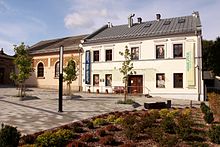
The communist Soviet Red Army re-invaded the town and liberated the camp on 27 January 1945, and then opened two of their own temporary camps for German prisoners of war in the complex of Auschwitz-Birkenau. The Auschwitz Soviet camp existed until autumn 1945, and the Birkenau camp lasted until spring 1946. Some 15,000 Germans were interned there. Furthermore, there was a camp of Communist secret police (Urząd Bezpieczeństwa) near the rail station in the complex of former "Gemeinschaftslager". Its prisoners were members of the NSDAP, Hitlerjugend, and BDM, as well as German civilians, the Volksdeutsche, and Upper Silesians who were disloyal to Poland.
After World War II
After the territorial changes of Poland immediately after World War II, new housing complexes in the town were developed with large buildings of rectangular and concrete constructions. The chemical industry became the main employer of the town and in later years, the service industry and trade were added. The many visits to the concentration camp memorial sites have become an important source of income for the town's businesses. After the end of communism, by the mid-1990s, employment at the chemical works (named Firma Chemiczna Dwory SA from 1997 to 2007, Synthos SA since then) had dropped from 10,000 in the communist era to only 1,500 people. In 1952, the County of Oświęcim was re-created, and the town until 1975 belonged to Kraków Voivodeship. In 1975–1999, it was part of Bielsko-Biała Voivodeship. In 1979, Oświęcim was visited by Pope John Paul II, and on 1 September 1980, a local Solidarity office was created at the chemical plant. On 28 May 2006, the town was visited by Pope Benedict XVI.
Culture
Oświęcim is culturally regarded as part of Upper Silesia. To this end, names such as 'Oświęcim Silesia' (Polish: Śląsk Oświęcimski) were used by Polish and German geographers, and Silesia was defined as the territory from the mouth of the river Warta to the Oder, up to Oświęcim. German nationalists of the 19th and 20th centuries argued that Oświęcim belonged to the German nation, as it is considered a part of Silesia, which led to its annexation directly into Nazi Germany instead of being included in the General Government.
Oświęcim is considered to be the eastern frontier of the Silesian language. As the easternmost point of linguistic Silesia, Silesian speech in Oświęcim is influenced by the Lesser Poland dialect and has distinct features such as partial mazuration (Polish: mazurzenie) - there is only one nasal 'a', which loses its nasality by becoming a non-labialised 'o' (rozpocoć – rozpocząć). Linguist Alexander Andrason outlines the linguistic area of Silesian borderland which Oświęcim is a part of, with features that distinguish it from other Silesian dialects as well as the Polish ones - for example, 'ą' and 'ę' are merged into /ɔ̃/ in Oświęcim Silesian.
Local sports
The sports club KS Unia Oświęcim was established in 1946. In 1999, the remaining four departments (ice hockey, swimming, figure skating, and association football) separated into their own clubs: TH Unia Oświęcim (ice hockey), UKŁF Unia Oświęcim (figure skating), UKP Unia Oświęcim (figure skating), Zasole-Unia Oświęcim (football), UKH Unia Oświęcim (youth ice hockey), and UKHK Unia Oświęcim (women's ice hockey). In the past, Unia had boxing, table tennis, volleyball, athletics, cycling, gymnastics, chess, motorcycle racing, lawn tennis, skiing, bridge, handball, and basketball departments. The ice hockey team, TH Unia Oświęcim, was crowned Polish champions 8 times, and finished as runners-up in 2022.
Another sports club with a long tradition is KS Soła Oświęcim, an association football club founded in 1919.
Notable people
See also: Category:People from Oświęcim


- Łukasz Górnicki (1527–1603), Polish Renaissance poet, humanist and political commentator
- Simon Syrenius (1540–1611), pre-Linnean Polish botanist and academic.
- Jeremiah Mattersdorf (ca. 1750-1805), rabbi and author
- Tadeusz Makowski (1882-1932), Polish painter who worked in France
- Tova Berlinski (1915–2022), Israeli painter
- Victor Zarnowitz (1919-2009), American economist
- Shimson Kleuger (1925–2000), known as "The Last Jew in Auschwitz".
- Henryk Waniek (born 1942), artist, stage-set designer and author-journalist
- Benzion Miller (born 1947), cantor; son of Aaron Daniel Miller, also cantor
- Marian Kasperczyk (FR Wiki) (born 1956), Polish-born French painter,
- Beata Szydło (born 1963), 16th Prime Minister of Poland
- Ela Orleans (born 1971), composer, multi-instrumentalist and singer.
- Marcin Czarnik (born 1976), film and theatre actor
Sport
- David Enoch (1901–1949), Israeli chess player.
- Arkadiusz Skrzypaszek (born 1968) double gold medallist at the Modern pentathlon at the 1992 Summer Olympics
- Mariusz Siudek (born 1972), figure skater
- Dorota Siudek (born 1975), figure skater
- Piotr Gruszka (born 1977), volleyball player and world champion
- Sabina Wojtala (born 1981), figure skater
- Paweł Korzeniowski (born 1985) (swimmer)
Members of Parliament (Sejm) for this constituency
- Zbigniew Biernat (PiS),
- Józef Brynkus (K'15)
- Ewa Filipiak (PiS),
- Dorota Niedziela (PO),
- Marek Polak (PiS),
- Marek Sowa (PO),
- Jarosław Szlachetka (PiS),
- Beata Szydło (PiS),
International relations
See also: List of twin towns and sister cities in PolandTwin towns and sister cities
Oświęcim is twinned with:
|
See also
- Auschwitz Jewish Center in Oświęcim
- Auschwitz Supermarket
- Oświęcim Jewish cemetery
- Tourism in Poland
- Mural trail in Oświęcim
Notes
- Ospenchin (1217), Osvencin (1280), Hospencin (1283), Osswetem (1293), Uspencin (1297), Oswentim (1302), Wswencim (1304), Auswintzen (1312), Oświęcim (1314), Oswencin (1327), Auswieczin (1372), Awswiczin (1372), Uswiczin (1400); Oświęcim was spelled Osswencimen or Osviecim(en) in Latin
References
Citations
- Kwiecień, Bogusław (13 January 2023). "Mieszkańcy Oświęcimia uciekają na wieś. W mieście znów ubyło mieszkańców, przybyło za to w miejscowościach gminy Oświęcim". naszemiasto.pl (in Polish).
- "Climate: Lesser Poland Voivodeship". climate-data.org.
- Dulias, Renata (2013). Denudacja antropogeniczna na obszarach górniczych na przykładzie Górnośląskiego Zagłębia Węglowego (in Polish). Katowice: Uniwersytet Śląski. p. 22. ISBN 978-83-62652-47-1.
- Anna Woźnicka; Karolina Merk; Sylwia Miszczak; Małgorzata Ukleja; Tomasz Mikołajczyk; Dominika Garbacz; Wioletta Młynarska (October 2020). "Studium Uwarunkowań i Kierunków Zagospodarowania Przestrzennego Miasta Oświęcimia" (PDF) (in Polish). Oświęcim. p. 48.
- Andrew Charlesworth; Robert Guzik; Michał Paszkowski; Alison Stenning (2005). "Przestrzenne bariery upamiętnienia: Oświęcim i państwowe muzeum Auschwitz-Birkenau". Geografia i Sacrum (in Polish). 1. Kraków: Instytut Geografii i Gospodarki Przesztrennej UJ: 125. ISBN 8388424424.
- Wróbel, Olga (12 March 2017). "Oświęcim? Jak można tam żyć?". krytykapolityczna.pl (in Polish).
- "Oświęcim - Średnia roczna pogoda na podstawie danych historycznych" (in Polish). meteoatlas.pl. Archived from the original on 19 February 2024. Retrieved 19 February 2024.
- "Klimat Oświęcim" (in Polish). pl.climate-data.org. 2019. Archived from the original on 1 October 2019. Retrieved 19 February 2024.
- Higgins, J. Patrick (2023). The Spirit of Laws in the Polish-Lithuanian Commonwealth, 1573-1791: Continuity, Change, and Conservative Jurisprudence. Łódź. p. 111.
{{cite book}}: CS1 maint: location missing publisher (link) - Elżbieta Skalińska-Dindorf, historian, State Archive in Oświęcim, The History of the City of Oświęcim. CHRONICLE via archive.org; accessed 16 November 2014.
- Prussian General Staff, The Campaign of 1866 in Germany, 1907, page 97.
- Balck, William, trans by Walter Krueger, Tactics, Volume II: Cavalry, Field, and Heavy Artilliery in Field Warfare; U.S. Cavalry Association, 1914, pg. 5
- "Szymon Kluger and his family before WW2". Virtual Museums of Małopolska. Retrieved 18 January 2024.
- Wolnerman, Ch.; Burstin, A.; Geshuri, M.S. (eds.). "ספר אושפיצין" [Oświęcim Memorial Book]. Translated by Oshpitzin, Sefer. Israel: Oświęcim Descendant and Survivor Association.
- Israely, Jeff (29 May 2006). "Pope Benedict's Auschwitz Prayer". TIME.
- ^ Artur Fabiś; Artur Łacina-Łanowski; Łukasz Tomczyk (2013). Kreatywna starość: 15-lecie oświęcimskiego Uniwersytetu Trzeciego Wieku (in Polish). Oświęcim: Wydawnictwo Państwowej Wyższej Szkoły Zawodowej. pp. 16–17. ISBN 978-83-930661-7-9.
- Nowakowski, Andrzej (1985). "Oświęcim i Zator lennem czeskim". Przegląd Historyczny (in Polish). 76 (3): 533–545.
- Rybka, Piotr (2017). Gwarowa wymowa mieszkańców Górnego Śląska w ujęciu akustycznym (in Polish). Katowice: Uniwersytet Śląski w Katowicach. p. 58.
- Kluz, Tomasz (11 October 2008). Zróżnicowanie regionalne i dialektalne współczesnego języka polskiego Dialekt małopolski i dialekt śląski (in Polish). Masaryk University. p. 85.
- Andrason, Alexander (6 October 2021). Polish Borrowings in Wymysorys:A Formal Linguistic Analysis of Germano-Slavonic Language Contact in Wilamowice. Reykjavík: University of Iceland. p. 116. ISBN 978-9935-9563-9-2.
- Historia klubu (in Polish)
- "Klub Sportowy Soła Oświęcim". 90minut.pl (in Polish). Retrieved 19 January 2024.
- "The last Jew living in the city of Auschwitz dies at 72". Jewish News of Northern California. 23 June 2000.
Sources
- Lange, Irena (1967). Oświęcim (in Polish). Zarząd Główny Związku Bojowników o Wolność i Demokrację.
External links
- "Auschwitz" . Encyclopædia Britannica. Vol. III (9th ed.). 1878. p. 100.
- Oświęcim, Poland at JewishGen
- Oświęcim at Virtual Shtetl
- The Oshpitzin Yizkor Database (1919–1941) at JewishGen
- All About Auschwitz at Our Poland
- James Glenday, "What's It Like to Live next to the World's Most Notorious Concentration Camp", Australian Broadcasting Corporation News, 24 February 2018 http://www.abc.net.au/news/2018-02-24/life-next-to-the-worlds-most-notorious-concentration-camp/9480916
- UC San Diego, Holocaust Living History Collection: Out of Oswiecim: A Family’s Odyssey
| Gmina Oświęcim | ||
|---|---|---|
| Seat (not part of the gmina) |  | |
| Villages | ||
| Gminas of Oświęcim County | ||
|---|---|---|
| Seat |
|  |
| Urban-rural gminas | ||
| Rural gminas | ||